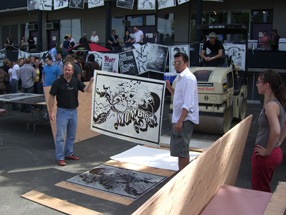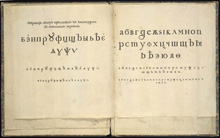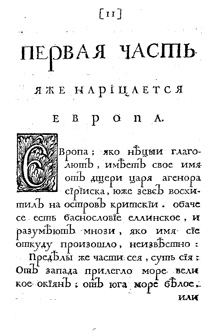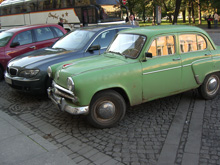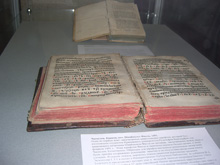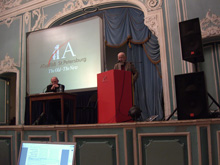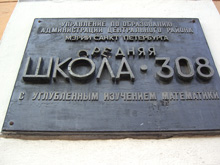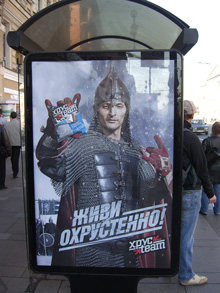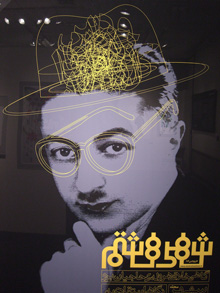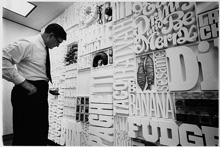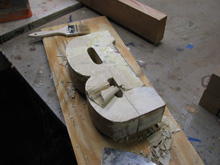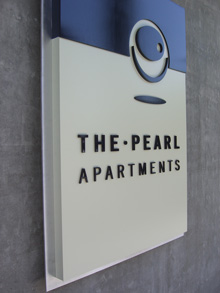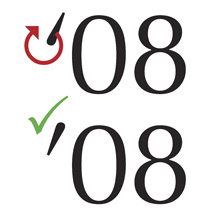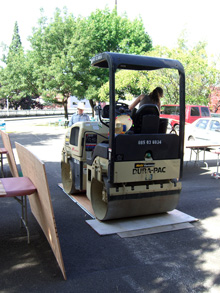When I opened up the recently arrived Washington State Voters’ Pamphlet (a hefty 136 pages, including the complete texts of various state and county initiatives), I was surprised to discover that there’s a typographer running for President of the United States. Or at least a labor leader with typographical connections. Gloria La Riva, the presidential candidate of the Party for Socialism and Liberation, lists her current occupation as “President, Typographical Sector, Media Workers Union, Local 39521, CWA (Communication Workers of America).” (Her running mate, Eugene Puryear, lists himself as a student and community organizer.) While I’m not about to vote for the La Riva/Puryear ticket, I am tickled to know that the long history of labor organizing in the typesetting and printing business has a place on the ballot this year.
easilyamused |
Archive for 2008
Type votes ’08
Published
Cyrillic goodies
Published
A little-noticed item was tucked into the goody bags handed out to members of the ATypI conference in St. Petersburg: a CD-ROM with a bright red label sporting the logo of the conference, plus titles, in Russian and English, saying: Первенцы гражданскйо печати / The first-borns of secular printing. The English subtitle explains it: Moscow editions 1708–1711. This little CD contains full scans of thirty-two books printed in Moscow in the very first years after Peter the Great’s drastic reform of the Russian alphabet.
“As they say in the supermarkets, an ‘unadvertised special’,” explained Maxim Zhukov on the ATypI members’ list. “A little gem hidden deep in the bag, just sitting there, waiting to be discovered.
“The idea of throwing into the ATypI’o8 goodie bag the CD-ROM prepared by Irina Fomenko and her friends of the Russian State Library (earlier known as Lenin Library) came very late in the game, two weeks before the conference opened. It turned out that (a) the ‘autorun’ thing only worked on IBM-compatibles, and (b) the introduction was in Russian. That was not surprising, given the usual target audience (domestic) of the RSL and its Rare Book Dept., and the OS most of the people in the world use (Windows). Translating, reformatting and reprogramming the CD-ROM would have taken forever, so we decided to offer the CD-ROM to the attendees of the SPb conference as is.”
The content is in Russian, but the images are wonderful no matter what language you read. And even if you’re viewing on a Mac and can’t take advantage of the “autorun” feature, it’s easy enough to just click on the links to the various PDFs, or open the PDFs directly, and browse through them. Among other things, this CD includes the complete printed specimen of the new Civil Type; we’re used to seeing an image of the first page, with Peter’s hand-scrawled corrections, but how many of us have seen the rest of the booklet? It’s here.
“Of course,” says Maxim, “the image resolution is not press quality. And yet, we never had it this good. For decades, all there was were the tenth-generation reproductions, heavily retouched, most of them coming from Abram Shitsgal books. And now… thirty-two Petrine books and other printed pieces scanned cover-to-cover! Isn’t that something.”
It is.
[Photos: top, interior spread from the first type specimen of the new Civil Type; below, a page from a 1710 book on geography, in the new type.]
Petersburg: the old · the new
Published
I got back last Tuesday from a week in St. Petersburg, Russia, for this year’s ATypI conference. The theme of the conference was “The Old · The New,” and we saw plenty of both – not only in contrast to each other but in many varied forms of both old and new. Our two principal venues, for instance, reflected different current uses for old buildings.
The main program was held in a 19th-century palace, the “pink palace” or Beloselsky-Belozersky Dvorets, which is situated right on the corner of Nevsky Prospekt, the Fifth Avenue of Petersburg, and the Fontanka river, which reminded me of the Seine in Paris. Inside the pink palace, we had two highly decorated function rooms, one an auditorium and the other more of a big seminar room. The old wooden floors creaked when people walked in or out, but otherwise the sound was good. The foyer in between was where we served lunch and had the coffee breaks, and where people could mingle (one of the main functions of an ATypI conference). In the evenings, we adjourned to a very different venue: the Loft Project Etagi (it should be spelled “Etazhi” in English, but the Latinization must be based on French), a five-storey former bread factory that’s been converted into art galleries, boutiques, and culture-related offices. As their description puts it, “The conversion of the space was minimal; as a result, many industrial artifacts have been kept as part of the interior setting: cast-iron floors, tied concrete columns, a boring mill [stet], backing equipment, etc.” This sort of “downtown” arts space contrasted nicely with the faded elegance of the pink palace. We put up the various exhibitions on the second floor of Etagi, and Friday night’s exhibition opening was open to the public; it was jammed. Saturday night we took over the top floor, a modern art gallery with a wine bar, for the main conference party. (This was a more informal replacement for the “gala dinner” that ATypI always used to have.) It was a fine party. Briefly we had to stop everyone from having fun so I could thank all the organizers and sponsors, and so a representative from the government press & arts entity could give a short speech and hand out commemorative plaques. After the party closed, I accompanied a group of typographers to a nearby bar, where we talked and drank until nearly 4 a.m. As I put it on Sunday, “I can no longer blame my exhaustion on jetlag; this time I’ve earned it fair and square.” But I was up for the first talk the next morning, ready to kick things off in my official capacity.
Everyone seemed to agree that the conference went well. There was a certain amount of division between the Russian-speakers and the non-Russian-speakers, as in general one track was in Russian and the other in English, but there was also a fair amount of fluidity and overlap. (We were trying to plan things to encourage as much cross-communication as possible, but some sorting by language is inevitable.) I couldn’t even begin to describe all the things that people spoke on or presented; it was generally a very good program. I ended up being the MC for one track some of the time, so I couldn’t be as flexible as an ordinary attendee in deciding which track to follow. And being president of ATypI, I was always feeling responsible, even when other people were actually carrying out the tasks.
Leaving on Tuesday meant that I had one full day free, after the end of the conference; and Monday turned out to be a gorgeous sunny day, not a cloud in the sky and temperatures around 60°F. I visited the Russian Museum, where I made a beeline for the 20th century art and found two iconic paintings of Anna Akhmatova; I also ran into a couple of people from the conference there. Otherwise I strolled up and down and over the canals, admiring the 19th-century buildings, most in a classic Italian style, and wandered through the Mikhailovsky Gardens and one end of the Summer Garden, past the brooding palace known as the Engineers’ Castle, finally enjoying a cup of coffee outside a Seattle-style coffee company (a local chain called “Coffee House”) on Malaya Sadovaya Street in the sunlight. Earlier, on Wednesday, after checking in with our conference director and making sure there wasn’t anything I needed to deal with, I walked my feet off (the long, wide avenues do go on a long way) and visited the Hermitage, where I finally got to reacquaint myself with the Van Gogh that I had first seen in DC in 1973, in a tour called “Impressionist and Post-Impressionist Paintings from the USSR.” That painting had brought tears to my eyes thirty-five years ago; today it didn’t, but still I spent ten or fifteen minutes just looking at it. I also renewed acquaintance with a number of other paintings that had been in that exhibition (Derain, Cézanne, Matisse) and saw many more that had not gone traveling.
[Photos, top to bottom: transport: the old, the new; the second book printed in Cyrillic (Krakow, 1491); Oleg Genisaretsky delivering the keynote address; School #308; advertising poster at a bus stop on Nevsky Prospekt – another take on the old, the new.]
Posters from Seattle & Tehran
Published
At Seattle’s Bumbershoot music and arts festival over Labor Day weekend, there was a remarkable exhibit: the Seattle–Tehran Poster Show. Curator Daniel R. Smith had gone to Tehran to investigate the graphic-design scene there, meeting as many local designers as he could, and he then put together this exhibition, which gives a parallax view of our two cultures. He paired each Iranian poster with one from Seattle, sometimes based on nothing more than a similar approach to letters or images or subject matter. Both cities have vibrant graphic-design communities, and both have created some wonderful posters.
The treatment of Arabic text is fascinating (that is, the Persian language, Farsi, which is written in the Arabic alphabet). Sometimes the letter forms are entirely deconstructed, given architectural or vegetal structure. When human faces or forms appear, they tend to be stylized, often intertwined with words. The Seattle posters, too, are interesting, but it’s clearly the work from Iran that grabs your attention.
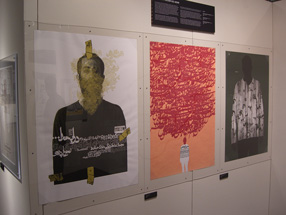

Bumbershoot only lasts over the holiday weekend, but a slightly different version of the show, called “Seattle–Tehran Poster Show Remix,” is up at the Design Commission in downtown Seattle until October 15. I intend to go down and check it out.
Wooden wall of text
Published
You may have seen photos of it in a design magazine or a book on graphic design in the Sixties: the 35-foot wall of words created by Lou Dorfsman and Herb Lubalin for the cafeteria of CBS television’s new corporate headquarters in 1966. The collage effect, and the lettering styles used, reflected the typographic aesthetic that was being popularized by Lubalin and Tom Carnase, which later bloomed into the establishment of ITC and Upper & lower case. Dorfsman conceived this “Gastrotypographicalassemblage” and art-directed its execution. He considers it his “Magnum Opus, his gift to the world.” It is certainly a monument to a particularly lively period in American graphic design.
But the 9-panel sculpture was removed and dumped in the late 1980s, after tastes had changed. The panels were salvaged by a New York designer, Nick Fasciano, and now the Center for Design Study, in Atlanta, is working to restore the damaged lettering and give the type wall a permanent home.
There’s a lot of restoration needed; time and neglect have taken their toll. Rick Anwyl, the Center’s interim executive director, estimates that it will take around $250,000 to fully restore the sculpture, “to see it as part of a permanent traveling exhibition on American Design, a tool for education and expanded awareness of the value of intelligently applied design.” The Center is a nonprofit foundation, and they’re actively soliciting donations to fund the restoration. Perhaps more importantly, they’re trying to think creatively about ways to approach raising the money. This is, obviously, not a small project.
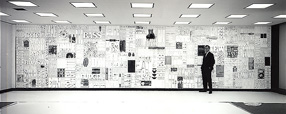
Well spaced
Published
Yesterday I was walking past a newly built apartment building on Seattle’s Capitol Hill when I noticed three people huddled around the rectangular frame next to the front door. They were in the process of peeling off a big piece of blank cardboard that had been covering the sign underneath. They were laughing and joking: “We ought to have a camera to record this!” I stopped and watched as they got the cardboard off, revealing the new, three-dimensional lettering that identified the building as the Pearl apartments. “It opens tomorrow,” one of them said, “and the first tenants will be moving in.”
I didn’t have a camera with me, but I went back later and snapped a couple of pictures, because that sign seemed like a good example of clear, simple signage. The lettering on the sign was remarkably well spaced – not so loose that it would fail to hold together within the larger space when you’re standing right in front of it, yet loose enough so it wouldn’t squish together when you view it from an angle, as you would if you were walking along the sidewalk. There are so many poorly conceived and poorly executed bits of public signage on our buildings that it’s a pleasure to see a new one that’s done well.
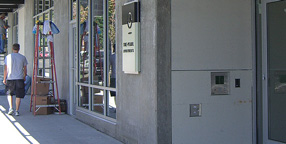

©ontent
Published
I’ve been reading Cory Doctorow’s new book of essays, Content: Selected Essays on Technology, Creativity, Copyright, and the Future of the Future, and finding it easy to read. This is not surprising, since I designed and typeset the interior of the book myself, but it’s reassuring when I actually have time to sit down with a copy of the finished, printed book and test that it’s truly readable. It is. (I’m not talking about the prose here; Cory’s writing is compulsively readable, in pretty much any format.) The author seems pretty happy with the design, too.
I’ve done a lot of book interiors for Tachyon Publications, but this was somewhat different from most of them. I wanted a typeface that was serious yet not too literary; it would have seemed silly to typeset Cory’s essays in Bembo, for instance. And it had to be very forgiving: it had to make a lot of different combinations of ALL CAPS and C4PS&NUMB3R5 look good, not like big undigestible chunks clogging up the flow of the prose. Normally I would use old-style figures in a book, and small caps for acronyms and anything set in all-caps. But in these essays, Cory uses a lot of acronyms – DVDs, FBI, RIAA, VHS, and DRM are just a few from a single essay – and there are some combinations of capital letters and numbers or other symbols that come from Leetspeak or keyboard-based typing habits that rely on the simplicity of plain ASCII characters. They’re part of the flow, not an interruption of it. This was not exactly an edition of the Penguin Classics.
The typeface I chose was Chaparral Pro, a sort of humanist slab-serif text face designed by the very talented former Adobe type designer Carol Twombly. Chaparral doesn’t have much variation in the width of the strokes, so it doesn’t look “bright” like Times Roman or Janson; but its letter forms are comfortable, familiar, and easygoing, and it reads well in long text. Chaparral has been a favorite of mine since it first came out, though I don’t often get a chance to use it in a book; it might seem a little strong for, say, a book of fiction. But it hit the right balance here. And its caps and its full-height lining figures don’t overpower the lowercase the way they do in some traditional book faces.
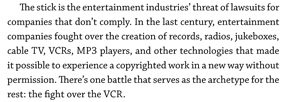
Although Chaparral does have old-style figures, the only place I used them was in the table of contents. Similarly, the font includes true small caps, but I only used them in the front matter and the running heads. In the body of the text, it was full caps and lining figures all the way through – in the spirit of the prose itself.
In making the physical object – what Cory calls the p-book – comfortable for carrying around and reading on the fly, it helps to keep it small and light, printed on flexible, off-white paper in a binding that opens freely. Worzalla, the printer, did a good job of this. The strikingly simple cover that Ann Monn designed stands out from other books, and it gets curious glances when you’re reading the book in a coffeehouse. The spine will also stand out on a bookshelf, a useful selling point for physical book-product.
The essays themselves? Read ’em.
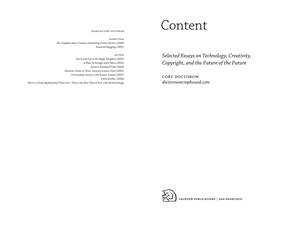
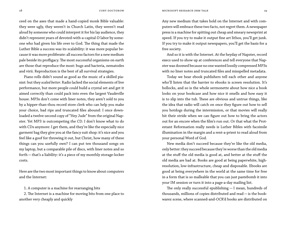
Backwards rolled the apostrophes
Published
There’s a wonderful photo on SFGate today, in a set of images from the just-completed Republican National Convention. It’s a shot of a couple of stagehands carrying a big sign down to the floor of the auditorium, in preparation for the event. The sign consists of giant Optima letters stuck to a ladder-like frame; the cap-height is about half the height of one of the guys carrying it. Naturally, the phrase spelled out so grandly is “McCAIN ’08” – except that the apostrophe (which is about the length of the guy’s head) is backwards.
There’s something peculiarly wonderful about a typographic error that has its origins in automated typesetting (“smart quotes”) being embodied in such a large, hands-on, physical form and lugged down the stairs to be erected in front of a huge crowd in a convention hall.
Orphan fonts
Published
Okay, ’fess up: who left the bag of type on the doorstep? A couple of weeks ago, I went out to pick up the morning paper and found a paper bag filled with metal type sitting on the front porch. No explanation; no note, no clue, no context. Was it you?
There’s about twenty-five pounds of individual type sorts in that bag, neatly arranged in smaller paper bags labeled “W” or “XY” or “H.” Each of those little bags contains sorts that have been, well, sorted by letter – but in any number of different typefaces. Most of them seem to be text sizes, though not all of them are what I would think of as text typefaces. A few are italic, with slanted edges to facilitate setting seriously slanted type. There’s a bag marked “SPACERS,” and another with no label, which seems to be just a fistful of pied type; that latter includes a few broken rubber bands, which suggests that once they may have been carefully organized. One clear plastic bag, at the top of the heap, seems to be all ornaments – again, in various styles, from various fonts.
Among the bags of type I found a small, dessicated slice of cheese – havarti, perhaps, or something that had once been havarti. A defector from someone’s lunch?
Anybody missing a whole mess o’ type?
Wayzgoose
Published
Summer’s been busy, though not always with things that are easily written up. But last Saturday I stopped by the letterpress printing fair at Seattle’s School of Visual Concepts, where a bunch of enthusiastic printers were creating great big posters – really big posters – by inking up linoleum blocks and then driving a steamroller over them. Well, it wasn’t technically a steamroller, since it didn’t run on steam; but it was certainly an impressive piece of roadbuilding equipment. This operation was publicized by the local AIGA, who entered a winning team in the “letterpress smackdown”; the event took its inspiration from Roadworks, the “Steamroller Printing Street Fair” that the San Francisco Center for the Book has been hosting every summer for several years. (The fifth annual Roadworks is coming up in September – unfortunately while I’ll be in Russia.)
For a short “slideshow” (with a bit of video) of the whole process put together by the AIGA folks, look here.
